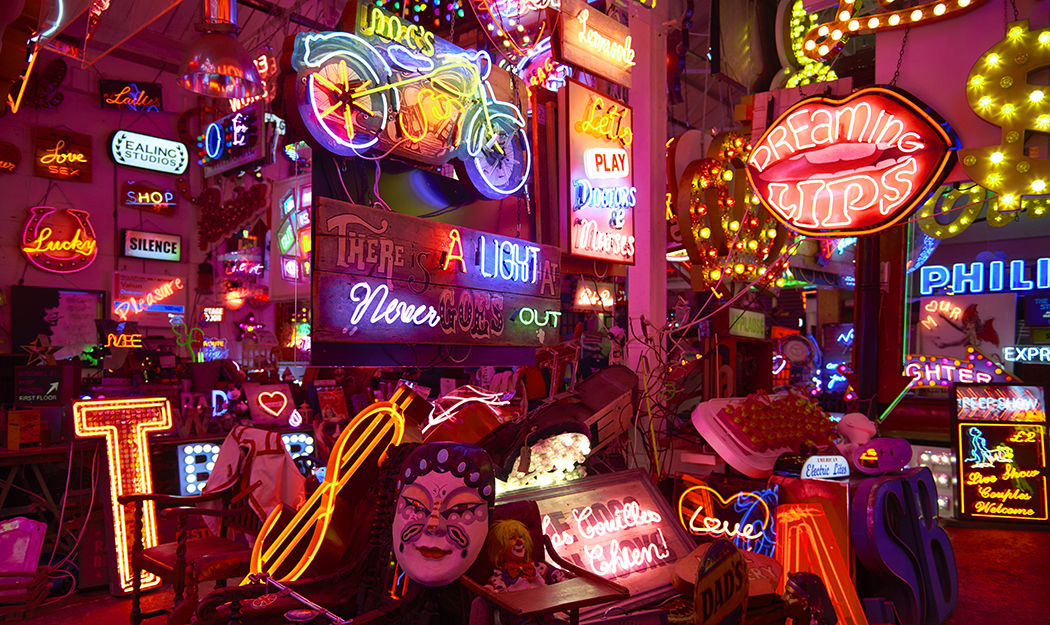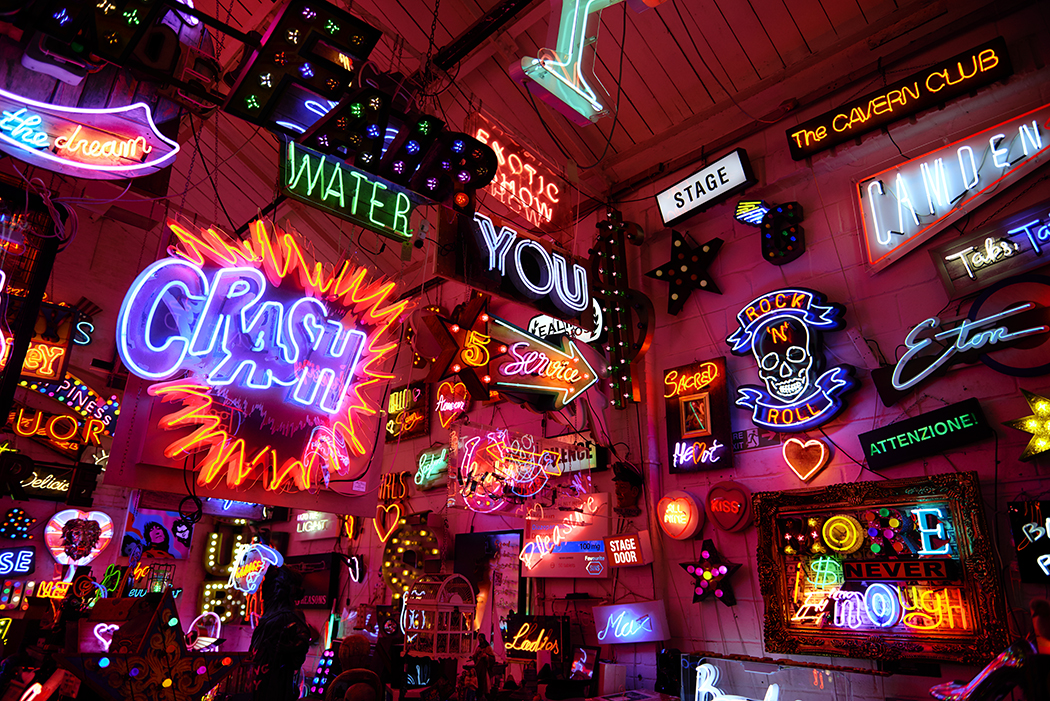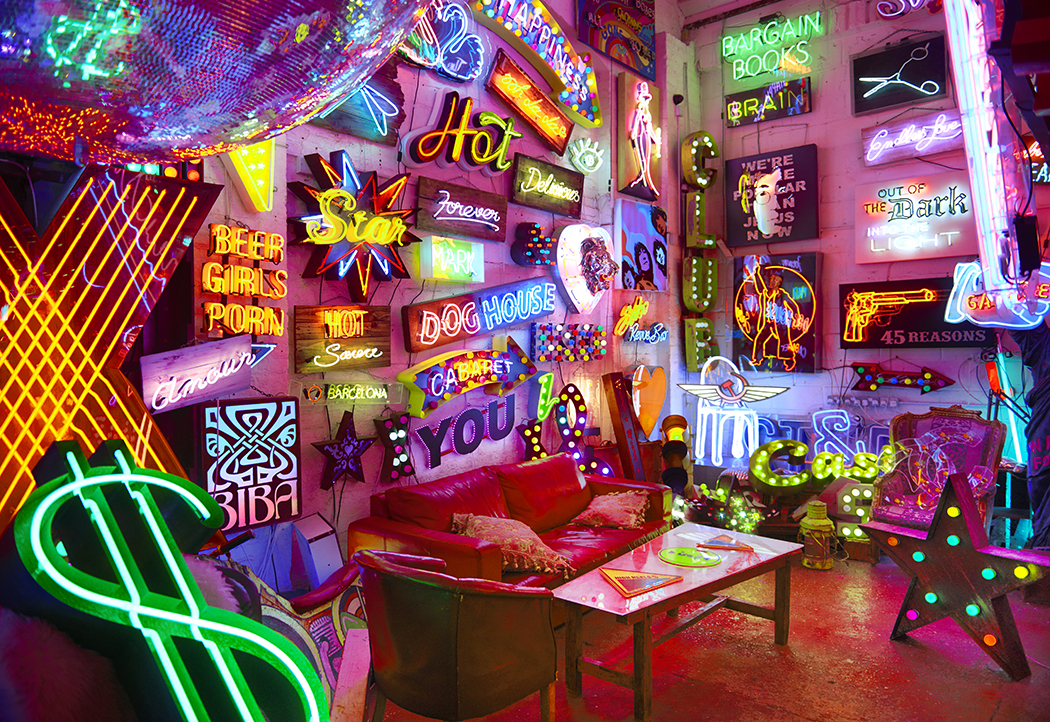God’s Own Junkyard is a gallery-museum and showroom operated by the Bracey family, which can be described as a neon dynasty. The family-owned company Electro Signs is based close by and is a major supplier and manufacturer of neon signs, LEDs and bulb signs, electro props, architectural signs, awnings, and banners.
God’s Own Junkyard is believed to be the largest collection anywhere of illuminated graphic systems of all types, some sculptures, mirror balls and the like, but mostly of hundreds of neon signs, most of them salvaged, of which 80 per cent are offered for sale at any time.

Neon happened first in London. “The blaze of crimson light from the tube told its own story and was a sight to dwell on and never forget”, said University College London chemist Morris Travers when the gas was first isolated by him and Sir William Ramsay in a UCL laboratory in Bloomsbury in 1898. Its first application was advertising signage, celebrated in God’s Own Junkyard in Walthamstow today.
This started with Richard Bracey, a Welsh coal miner who came to London after the Second World War, trained as electrician and started work with company called Power Neon, an established maker of neon signs. He lived in the East End and worked on installations across London, including helping to maintain the array of neon at Piccadilly Circus.
LOCAL ADVERTISING
In 1952 he started Electro Signs, a workshop supplying neon to circuses, entertainment arcades and funfairs around London, in the south east and at seaside towns along the east coast. One of the early Bracey signs was for the Bar Italia on Frith Street, its neon incorporating a clock with the glowing words Caffe Espresso and Universal, a classic sign of its time which survives today.
It was an early example of the company’s work in Soho, which was soon to become a dominant market. In 1958 the famous Paul Raymond Revuebar opened at 11 Walkers Court highlighting its striptease with a towering Richard Bracey-designed and constructed sign. Soho, a colourful place in every respect, continued to be a rewarding but sometimes tough environment for Electro Signs through the 1960s and 1970s.
From 1972 Richard’s son Chris Bracey, knowledgeable in graphics and design, increasingly guided the company. He was to become a creator of fluorescent tube artworks and a collector of signs. A turning point came in 1986 when a film art department assistant asked for Chris Bracey’s help in gaining access to a Soho club location for a forthcoming feature.

The film was Mona Lisa, with Neil Jordan directing and Bob Hoskins starring. It required authentic London backdrops, and also some neon signs to dress the set. A deal was done. More film neon work followed with Batman, Eyes Wide Shut and for Charlie and the Chocolate Factory, Judge Dredd, Tomb Raider and Mission Impossible. On Chris Bracey’s death in 2014 his son Matthew came to head the company with his mother and brothers.
The film connection and TV connections continue with either custom pieces or examples drawn from GOJ, and Matthew Bracey is an established neon light artist. The company has traditionally created a Christmas exhibition for Selfridge’s windows.
Neon has largely been displaced by liquid crystal displays and LEDs for mainstream advertising purposes, for example the last big sign at Piccadilly Circus illuminated by neon, owned by Sanyo, was shut down and removed in 2011, while at the same time there is a growing appreciation of neon as a artform.
God’s Own Junkyard has sold pieces to Grayson Perry, Kate Moss, Damien Hirst and Vivienne Westwood, and Lady Gaga. Eighty per cent of commissioned works are for display in home.

Soho changed. The Raymond Revuebar sign was restored, rehabilitated and reinstalled in 2014. It reads ‘personal appearances of the world’s greatest names in striptease – lavish revue – licenced bars’ but the show has long gone. Fawn and India James, granddaughters of Paul Raymond, commissioned it as a tribute to their grandfather and as a piece of public art for Soho. The sign was remade by the Braceys.
About the name of the collection: Chris Bracey, actively collecting neon signs since the 1970s, may have been stirred by a visit to the Neon Boneyard in Las Vegas, a storage facility for old signs, or he was inspired by the words God’s Own Junkyard from architectural writer Peter Blake’s 1963 book about the visual ruination of America. That may be ironic, because Blake identified the proliferation of signs and billboards as a major damaging force.
In any case, the Junkyard at Walthamstow is informed throughout by a kind of rock ‘n’ roll sensibility, the words hip, funky and retro apply, it is high in kitsch, sometimes lower in tone and always exciting. There is even a café there called The Rolling Scones.
Opening hours are restricted to Friday-Sunday, God’s Own Junkyard, Unit 12, Ravenswood Industrial Estate, Shernhall St, E17 9HQ.
Main image: Gods Own Junk Yard. © Peter Dazeley

